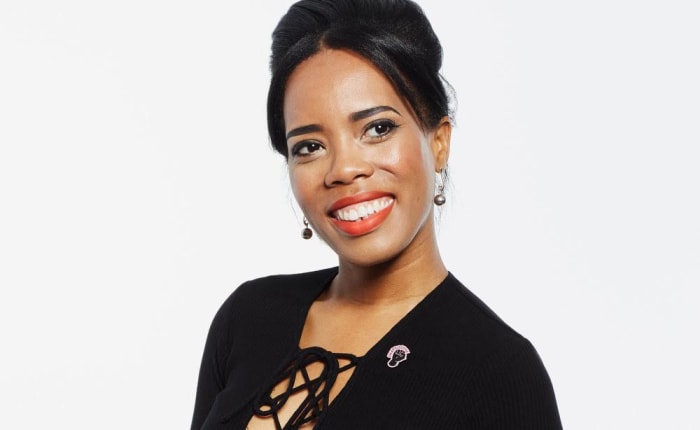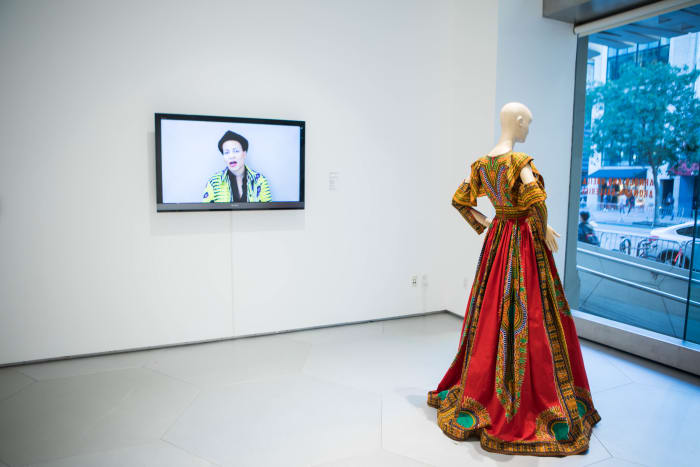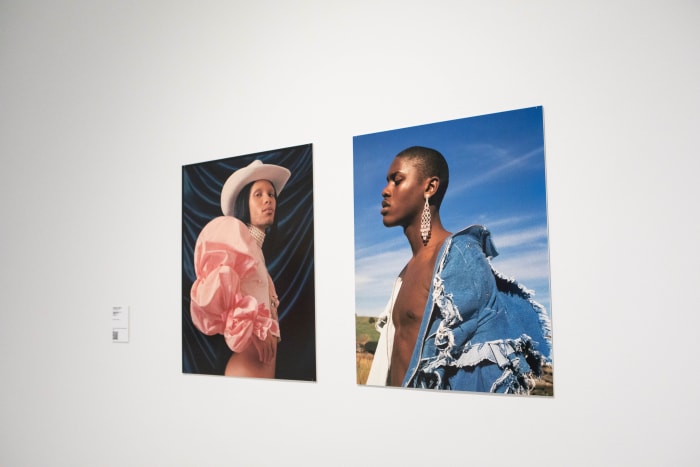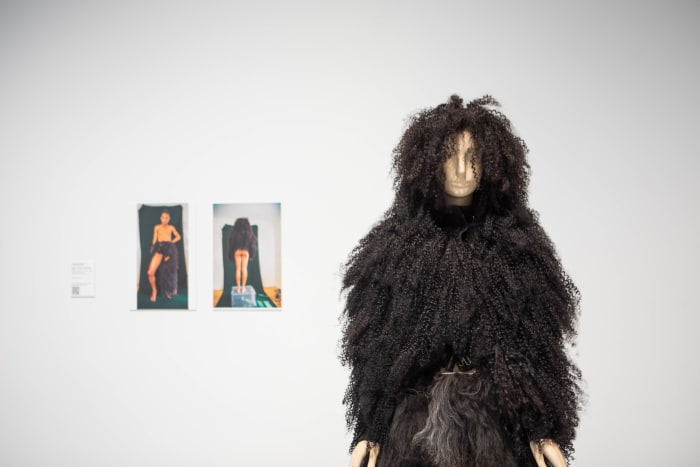Fashion and Race Deconstructing Ideas Reconstructing Identities

Kimberly Jenkins. Photo: Anastasia Garcia
Why do we vesture what we wear, and how does race play a part in our clothing choices?
This is only one of the many challenging questions scholar Kimberly Jenkins asks herself each and every day. From a young age, Jenkins — who at present works as a part-time lecturer at Parsons School of Design and a visiting assistant professor at Pratt Constitute — developed an interest in both the sociocultural and historical influences behind fashion and dress, only wasn't sure how to merge her passions together. It wasn't until she discovered an MA plan in Manner Studies at Parsons that she realized could pave her own way in the industry.
After graduating from the programme in 2013, Jenkins ultimately began didactics her "Mode and Race" course at Parsons in 2016, which quickly became one of the near sought later on classes at the university. Since and so, Jenkins has become an emerging vocalism and a cultural pioneer in the study of mode and identity, encouraging her students and peers to consider how politics, psychology, race and gender shape the ways we "fashion" our personal identities. Beyond this, Jenkins has been busy organizing topical panels, speaking equally a guest lecturer, launching (and running) a related online database and curating a new exhibition, chosen "Way and Race: Deconstructing Ideas, Reconstructing Identities," which progresses many of the themes she addresses in her classes.
The prove, taking identify at Parsons from Oct. 27 to Nov. 11, puts the work of eleven students and alumni on display, investigating issues such as "misrepresentation, exclusionary beauty standards, the lack of inclusion and systemic violence in their creative practice," according to the printing release.
In the wake of the opening, Fashionista sabbatum down with Jenkins to learn more nearly her piece of work and how her Parsons exhibit considers the fashion industry'due south exclusionary by while proposing a radical new future. Read on for the full conversation.

Photo: Courtesy of Parsons
When and how did yous start become interested in the intersection of fashion and race?
As a person of color, I discovered the thought of race at a very immature age, since most of my lived experience has been shaped by it. As a child, I was enthralled by fashionable women. My interest in fashion adult through media representation — "Style" on CNN with Elsa Klensch, "House of Style" with Cindy Crawford, poring over fashion magazines. In eighth grade I wrote a report on the dress signifiers of Skinheads; past loftier school I had get sort of obsessed with race, social psychology and belief systems. By college, I didn't know what I should major in considering I didn't know how to reconcile my involvement in social and cultural issues with "fashion" and dress — style is stigmatized as existence frivolous and unworthy of scholarly examination. I discovered a graduate programme called Fashion Studies at Parsons School of Blueprint nearly 2 years subsequently graduating with my BA, so I was obviously elated to see my academic interests legitimized.
What other factors do y'all try to accost in your piece of work?
My exploration and teaching of way and race is actually simply i of the various aspects of fashion and self-presentation that I am fascinated with. In my classes, I talk to my students about all of the "fashion and's" — like "fashion and crumbling," "fashion and politics," "fashion and psychology," "fashion and sustainability," and and so on. My master'south thesis was about how we dress and manage our appearance when we go through a divorce or breakup.
Can you tell us more near the classes y'all teach and your arroyo to educating the side by side generation of fashion designers?
The classes I teach run the gamut from mode history (what we wore) to fashion theory (why we wear it). I also teach a research methods grade that shows fashion blueprint students how to expand the depths of their inspiration. When I developed my "Fashion and Race" class, I hoped to bring something sorely needed in fashion schools: a diverse and confusing perspective. All likewise often, students are presented with a very Western, and allow'southward just say it, a verywhite perspective of fashion history. I call up it's fourth dimension to broaden the definition of way and also augment what we know near clothing and fashion. Sure, we could argue that fashion "with a capital F" came out of Europe, just wouldn't it exist interesting to learn nearly dress from cultures and regions outside of Europe that convey only as much meaning in terms of style or prestige?

Photo: Courtesy of Parsons
What do you encourage your students to consider when it comes to addressing race and identity through fashion?
A hot topic that I know I must address in my grade is cultural appropriation. I agree with scholar Minh-Ha Pham that it's time to retire the term (unless yous are a manner law professional person), but I nevertheless find information technology useful as an entry point into talking nigh mode, buying and power sharing. I don't call back it's useful to say that no one should ever habiliment anything that is non native to their identity or upbringing, but I exercise retrieve that there needs to be a conversation near what something means and why. Paradoxically, every bit the world has get smaller and more connected, nosotros take in many ways become more tribal and isolated. We build upwardly walls and plug our ears and that'southward what I see happening in style when the personal becomes political.
What is the Fashion and Race Database? How practise y'all hope it'll increment consciousness regarding the means the 2 subjects are linked together?
The goal for The Fashion and Race Database Project is to provide a dedicated platform with open-source tools that accost the intersection of power, privilege, representation and aesthetics within the mode system. There has been such a warm and supportive reception since I launched the website, as students, educators and fashion enthusiasts have all agreed that we need to diversify and decolonize the means we think and talk about manner, wearing apparel and style. For many educators information technology will provide valuable teaching tools that helps the locate the bullheaded spots of their work.
Coil to Go on
Recommended Manufactures
In recent times, "activism" has get a fashion buzzword, as more than and more corporations are capitalizing on it. Do you think it'southward nonetheless relevant or has it lost its meaning?
Coming back to what I was saying before most the personal being political, I think that our everyday dress and appearance can advocate — or at the very least but express — how we feel and what we value most almost ourselves. That everyday human activity of self-expression communicates something deeper and, for ameliorate or for worse, the signals that information technology sends can cross with those who see things differently or don't respect who nosotros are.

Photograph: Courtesy of Parsons
All of this is to say that clothes is an active, everyday practice of self-expression and capitalizing on that democratic human action is something that, in my heed, makes the potency and possibilities of self-fashioning lose its richness. But I'thousand no fun for the fashion industry — I wear vintage and secondhand, or I vesture projects designed past way graduates. I've been seeing a market place sally for fashion activism and cultural "wokeness" that is so self-interested and inauthentic.
When it comes to addressing social problems through apparel, what do you promise to see more from the fashion manufacture in the hereafter?
I have a concern about appearance and discrimination — specifically, the racialized trunk is a visible, concrete expression and, in many cases, misperception, of someone's identity. This leads to appearances that become criminalized, exploited, appropriated and seen equally unfashionable... well, until information technology can be capitalized upon. The manner industry is oft seen as superficial, parasitic, ever-irresolute and exclusive. Information technology is my hope that, as nosotros navigate these precarious times politically, the fashion industry can evidence how what it does best — to innovate and inspire — can lead the path towards showing more empathy in pedagogy, design and business organisation.
Tell usa more well-nigh the "Fashion and Race: Deconstructing Ideas, Reconstructing Identities" exhibit. What kind of works are on display?
I've divided the exhibition into three sections. The first is "Deconstructing Ideas, Reconstructing Identities" which has piece of work from Cecile Mouen, Avery Youngblood (a Beyonce "Germination Scholar") and Joy Douglas that grapples with, subverts and interrogates the existence of race, respectively. Cecile has these ii large frames that each display a flat garment with symbols relating to biology and survey data painted on the surface. The information corresponds to the information acquired from interviews Cecile conducted with young, multiracial, multinational women who wrestle with the feet of appearance and authenticity.

Photo: Courtesy of Parsons
Then at that place is the section titled "The Racialized Body," which confronts and reckons with the longstanding, dehumanizing and reductive representations of Black women. Inside the gallery, you can see the fashion design work of Kyemah McEntyre (who went viral for her self-empowering prom wearing apparel in 2015), Katiuscia Gregoire, Carly Heywood and Lashun Costor all standing in chat with one some other to evidence united states what is possible for the next generation of Black woman way designers. We besides take the analogy piece of work of Jamilla Okubo (whose work has too enjoyed a collaboration with Dior), whose Hair as Identity zine presents an intervention with the rhetoric Black women have been told virtually their pilus texture and appearance.
The final section, "The Intersection of the Race and the Gaze in Fashion Photography," sheds a spotlight on the side by side generation of photographers of color. It's a beautiful moment for i of the photographers featured, Rachel Gibbons, as I remember her mentioning in the form "Fashion and Race" that she didn't run across many Black woman fashion photographers out there.
At that place's the piece of work of photography wunderkind Myles Loftin who has already enjoyed quite a bit of visibility, but his serial "Hooded", which reclaims "Black boy joy" and implores a sense of humanity whilst wearing the stigmatized hoodie, was absolutely imperative for this show. Stevens Añazco rounds out the group nicely with lustrous and tender photography that centers queer, non-binary and trans bodies of colour. Finally, I collaborated with Media Studies graduate Jessica Hughee to moving picture three narratives about what it'due south similar to piece of work in the creative field as a person of color. This storytelling component plays on loop inside the gallery calculation an actual phonation and ambient sound to the exhibition. The viewer doesn't go out the space without being touched by that added sensory experience.
What do you hope viewers volition accept away from seeing the exhibition?
It is my hope that those who accept felt marginalized in the way system — or but in general, socially — experience seen. My goal is to farther legitimize how fashion can be examined critically and too be a crucial tool for self-conclusion.
What'due south up next for you? What kind of projects do you want to accept on in the future?
Adjacent on my agenda is a podcast with a companion talk series that generates knowledge and understanding through fashion edutainment. One time that is off the ground, a volume.
This interview has been edited and condensed for clarity.
Want the latest fashion industry news commencement? Sign up for our daily newsletter.
0 Response to "Fashion and Race Deconstructing Ideas Reconstructing Identities"
Post a Comment